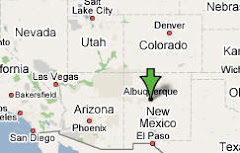Contrary to popular belief, not all of New Mexico is arid, God-forsaken land. The Rio Grande river is one of the largest rivers in North America, beginning in the Rocky Mountains and running smack down the middle of the state, dividing it East from West, and providing much of
 the water for the state. Early Spanish settlers that established agricultural practices put in various irrigation systems to tap into the river, some of which still exist today. The irrigation system we have available for our land is a community acequia system; a system of canals, gates, and individual turnouts that's regulated by our local Middle Rio Grande Conservancy District.
the water for the state. Early Spanish settlers that established agricultural practices put in various irrigation systems to tap into the river, some of which still exist today. The irrigation system we have available for our land is a community acequia system; a system of canals, gates, and individual turnouts that's regulated by our local Middle Rio Grande Conservancy District.The politics--and emotions--behind any community water system like this run deep, and we saw some of these play out when we flooded our property on a gorgeous Sunday afternoon. If you've ever read or seen the charming Milagro Beanfield War, you have a taste for what we experienced. It's as if the moment someone saw us fussing around in the canal, the neighborhood set aflame with word that someone new was flooding!


To keep the flood from seeping into our house, we had to have some kind of trench or moat around the area we wanted to flood. Lacking a tractor and having only two days' notice from the ditch rider that water was to be released that weekend, Jon dug a trench by himself--with a shovel. He dug 7-8 hours a day for two days, and our land isn't a roll of Charmin. Much of it is loamy clay which turns into cement-like hardpan if neglected, and according to our neighbors, no one has tended our land in about 12 years. Ouch.




Capturing the water and routing it to release onto our land was a fascinating process. Because no one had irrigated our land in over a decade, we had no gates or boards to block the canal and build up enough water to fill our turnout, and ultimately flood our field. So Jon had to buy some wood and equipment to craft a stacked gate system that would give him control over the water flow. He drilled a few holes in each of the 2x6 boards that stack up on one another to ease pressure from the accumulating water so the boards wouldn't break. Brilliant. We were like beavers creating our own dam system (come to think of it, we saw a beaver swimming down the canal later that evening).




Watching the water rise on our land was intimidating. We weren't sure if Jon's homemade trench would hold, but thank God it did! The water accumulated about 6 inches over an acre of our property, and with Jon's stacking board system and keeping a careful eye on the flow, we shut off the water just in time. Standing in the middle of the flood was a unique experience--we're sure a whole new ecosystem of organisms is now calling our land home, and it's just what we need to prepare our soil for some good, organic farming.
Best of all, choosing to flood our field allowed us to experience community like we've never experienced before. All manner of neighbors came out to chat and to offer help and advice--some friendly, and some entitled and antagonistic (it takes all kinds...). But most of our neighbors were cordial, advising how to manage the water flow, riding the ditch on their four-wheelers to help us time the waterflow from upstream (a few properties north of us irrigated that day--mostly horse farms and manicured lawns), showing us how to open our turnouts, etc. and just to generally hang out and enjoy a sunny afternoon.

Jon's well-deserved celebratory beer after a weekend of digging trenches and flooding.


2 comments:
Congratulations! We admire you both for shaping your dream so well....two city folk working the land. Uncle Mr. Ashe, I bet beer never tasted so good. Ahhhhh!
J-Lu/2
Dude?
Post a Comment